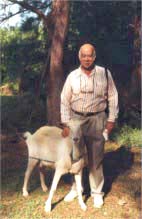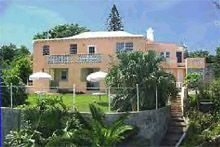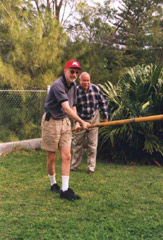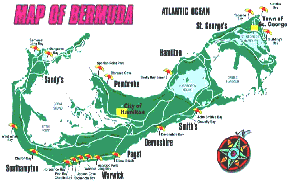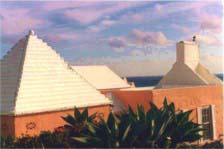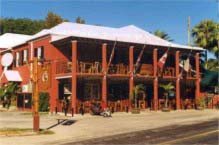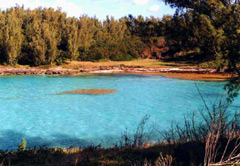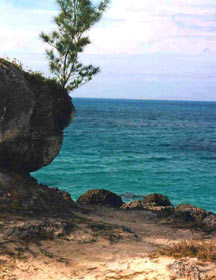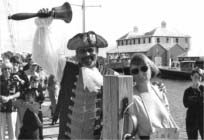Arrival
Our host, Ed Kelly, VP9GE, and "Go-at"
Bermuda lies about 600 miles off the Eastern seaboard of the US, due east of the Carolinas. It is officially a British Overseas Territory.
We booked a flight through Atlanta on Delta Airlines and got there easily in one day. Passports are required, but getting through customs is no problem with radio equipment.
You will need to tell the customs inspector where you are staying and how you are getting there, since there are no rental cars. Driving is on the left side like in England, if you were allowed. Renting a car is not an option. All travel is by motorscooter or by public transport.
Closer View of Tarrafal Apartments
(put mouse over image for view from apartment)
Putting up the mast for 20 meter bi-square. Put mouse over picture for another view.
On our arrival, Ed handed me my official Bermuda license in an envelope labelled "Her Majesty's Service". I felt just like 007. You cannot receive a VP9 callsign without a lot of red tape, including proof of making 500? CW contacts while in residence.
I had brought along my FT-890 HF mobile rig, antenna tuner, memory keyer, and laptop for logging. Ed made sure I got on the air the first night, helping me put up a 135 ft off-center fed dipole strung between a pine tree and his chimney. Ed now has an all-band G5RV and an R6000 vertical available.
I also experimented with a 20m bi-square aimed at Europe, which Ed and I erected using 24 ft of interlocking aluminum mast pieces (3 ft sections). I fed the system with 450 ohm ladder at the base. Loop is open at the top. It worked well and seemed directional
Drag mouse over the map to see Bermuda's relationship to US and Latin America.
Enlarged map of Bermuda with VP9GE's location!
Stair stepped roofs attenuate runoff during rainstorms
Put mouse over picture for view of our bus stop near Tarrafal.
Swizzle Inn, Swagger Out
Click picture for larger view.
We got a dose of the local culture with several trips to the nearby Swizzle Inn, a public house about a half mile from Tarrafal. Their speicialty is the "Dark and Stormy", which is several fruit juices with an equal amount of rum and ginger beer. The Swizzle Inn's motto: "Swizzle Inn, Swagger Out." They also feature a variety of "bar meals" such as "steak and kidney pie" and "bangers and mash" reminiscent of Old London pub fare.
Operating on the lawn at Tarrafal
I got to operate about 40 hours during the trip. Most days, I got up early to work during my grayline and take advantage of the excellent propagation into EU on the high bands. After touring during the mid day hours, I usually got an hour or so of CQing on 17 or 20 before dinner, and then settled in on 30, 40, and 80 with long pileups into Europe and NA. VP9 is still "rare" to many, especially CW on the WARC bands.
What happens after a couple of CQs? Just listen! How many called can you pick out?
Whalebone Bay (Drag mouse over picture to see Carol's watercolor)
Carol brought her small watercolor set and got several chances to do some outdoor studies. Ed thought Whalebone Bay would be a good choice, and she produced the painting that you can view by moving the mouse over the picture!
A point near Tarrafal looking north on the Atlantic. Click for larger image.
We were awed by the multi-colored waters around the shoreline at Bermuda beaches. The island lies at the top of an extinct volcano in the ocean which drops off drastically in all directions from a shallow reef.
The color gradients are caused by the different depths in the water and the corresponding sunlight reflectance properties at those depths.
Mock Ducking Trial
Drag mouse over picture to see more.
What's going on here? Carol has been convicted of "gossiping and nagging" by St. George's town crier, E. Michael Jones! Seems she asked too many questions during his lecture. Her penance is a seat on the ducking stool, poised over the pier (put mouse on picture). Michael plays out this scene daily with tours that visit the old town hall where he lectures on the duties of the town crier. He has won many international awards in town crier competitions.
Moongates are a tradition in Bermuda.
Crystal Cave was discovered by two young boys around 1900 who lost a ball that rolled down into a crevasse. It's a limestone cave about 60 feet under the surface with fresh water trapped within. The formations were spectacular.
